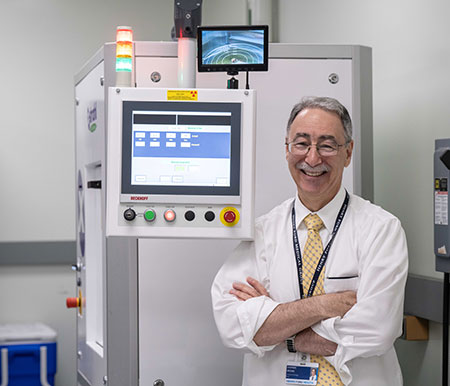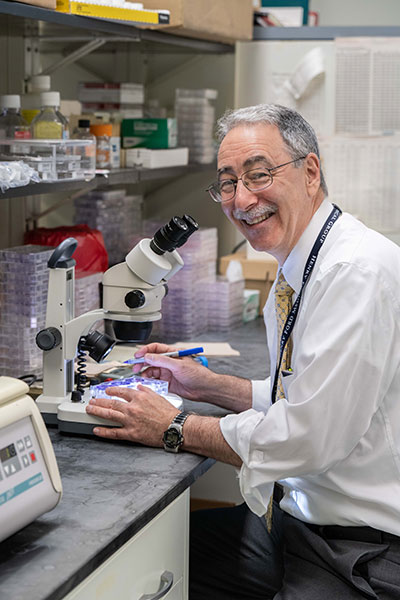A new way to "seek and destroy" cancer cells
Henry Ford research team patents clever use of chemistry and physics together; next step is securing funding for clinical trials.
 Stephen Brown, PhD, introduces himself with a friendly smile. It’s the humble demeanor of a person whose drive, intelligence and scientific curiosity have quietly worked for decades to improve and extend the lives of cancer patients.
Stephen Brown, PhD, introduces himself with a friendly smile. It’s the humble demeanor of a person whose drive, intelligence and scientific curiosity have quietly worked for decades to improve and extend the lives of cancer patients.
The moment you enter his laboratory and he starts to explain his life’s work you begin to pick up on the excitement of what is possible among the equipment, slides, vials and wall to wall shelves. Since 2020, Dr. Brown has served as the director of the Radiation Biology Laboratory for the Henry Ford Health Radiation Oncology Department. He’s been a research scientist at Henry Ford since 1990, focused on cancer.
Dr. Brown is one of 695 Henry Ford Health research investigators working on 2,600 active projects. This remarkable group, together with other researchers at Henry Ford and MSU, will soon have a new building to call home, a major component of the Future of Health: Detroit, a $3 billion development anchored by a major Henry Ford Hospital expansion, as well as housing and retail by the Detroit Pistons.
Dr. Brown’s ongoing work in partnership with Dr. James Ewing, a magnetic resonance expert, includes developing and testing predictors of long-term tumor response to radiation therapy. Tumor pressure appears to be key. When it is elevated, tumors are aggressive. When it is reduced, such as after a curative dose of radiation, the pressure in the tumor decreases. Their work, supported by NIH funding, has led to the hypothesis that a tumor’s response to therapy is controlled by the cancer cells at the boundary of the tumor.
Beating cancer
One exciting strategy is a unique therapy Dr. Brown and his colleagues have patented and are seeking funding to begin clinical trials. It’s a new way to target tumors with radiation treatment using metals.
“You can cure any tumor with enough radiation, but the concern is with damaging healthy tissue,” he said.
 The desire to use as little radiation as possible to treat cancer is nothing new. Dr. Brown is a physicist by training, but it was the collaboration with chemist and practicing radiation oncologist, Dr. Derek Isrow to bring the two disciplines together that made the difference.
The desire to use as little radiation as possible to treat cancer is nothing new. Dr. Brown is a physicist by training, but it was the collaboration with chemist and practicing radiation oncologist, Dr. Derek Isrow to bring the two disciplines together that made the difference.
They knew that metal stops radiation, effectively increasing its absorption. Their idea is to target the metal to molecular targets on cancer cells using organic compounds and to use high-energy radiation to further enhance the effect. The team has patented using organometallic complexes to enhance the effects of high-energy radiation in cancer treatment.
This innovative method was demonstrated by introducing a metallic compound directly into the area where the cancer was located. When high energy radiation was applied, the metal efficiently absorbed the radiation by the cancer cells. This has the potential to minimize damage to surrounding healthy tissue. The innovation is that the presence of the metal makes the high energy radiation, through a process called pair-production, far more devastating to the cancer cells themselves, significantly improving the treatment’s effectiveness.
“This therapy capitalizes on biology and chemistry to get more ‘bang for your buck’ with each treatment,” Dr. Brown explains. “The metal is non-toxic to patients and can be introduced to specific cells.
“This is a perfect example of precision medicine. Seek and destroy (cancer cells) is the best way for me to put it,” says Benjamin Movsas, MD, Henry Ford’s Chair of Radiation Oncology and Medical Director of Henry Ford - Cancer.
Next stop: Clinical trials
So why isn’t this being used in clinics all over the world already? Those outside the research community have little idea of the years – sometimes decades – it takes for a really good idea to make its way into clinical use. The next step is additional preclinical testing, then clinical trials and finally FDA approval, which can cost millions of dollars. The team is working diligently with the help of Henry Ford Innovations to secure the funding to continue to move the research forward.
In the meantime, Dr. Brown recently won the prestigious Jae Ho Kim Outstanding Oncologist Award – Scientist Category. Since 2022 he also wears the hat of research professor, Department of Radiology, Michigan State University School of Medicine, just one in a long history of educating the next generation of physicians and scientists.
Dr. Brown’s own journey as a researcher began at a young age. He’s known he wanted to be a cancer scientist since eighth grade when his grandfather died of prostate cancer.
“Since then it’s really been a straight line to where I am today,” he said. He said there is beauty and gratification to his work. “That’s my life’s goal (to improve health). None of us are here forever and we need to use our talents in the best way possible. Seeing this therapy in standard use – that would be my life’s dream.”
.svg?iar=0&hash=F6049510E33E4E6D8196C26CCC0A64A4)
/hfh-logo-main--white.svg?iar=0&hash=ED491CBFADFB7670FAE94559C98D7798)